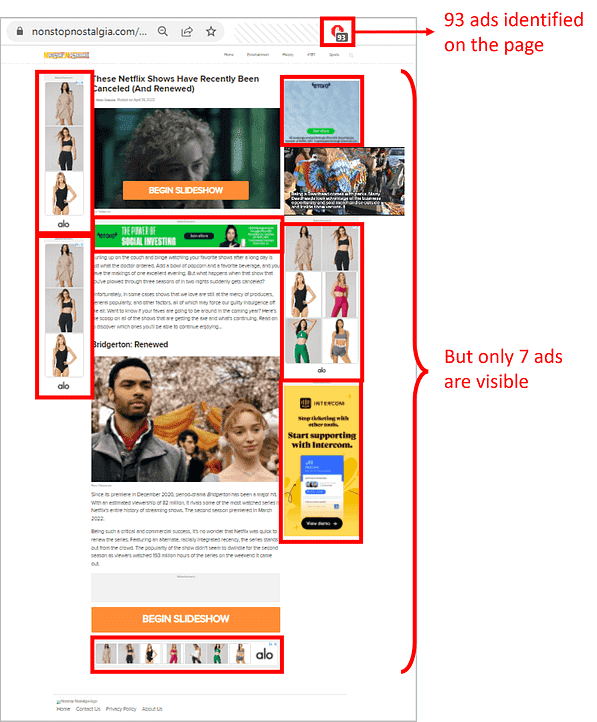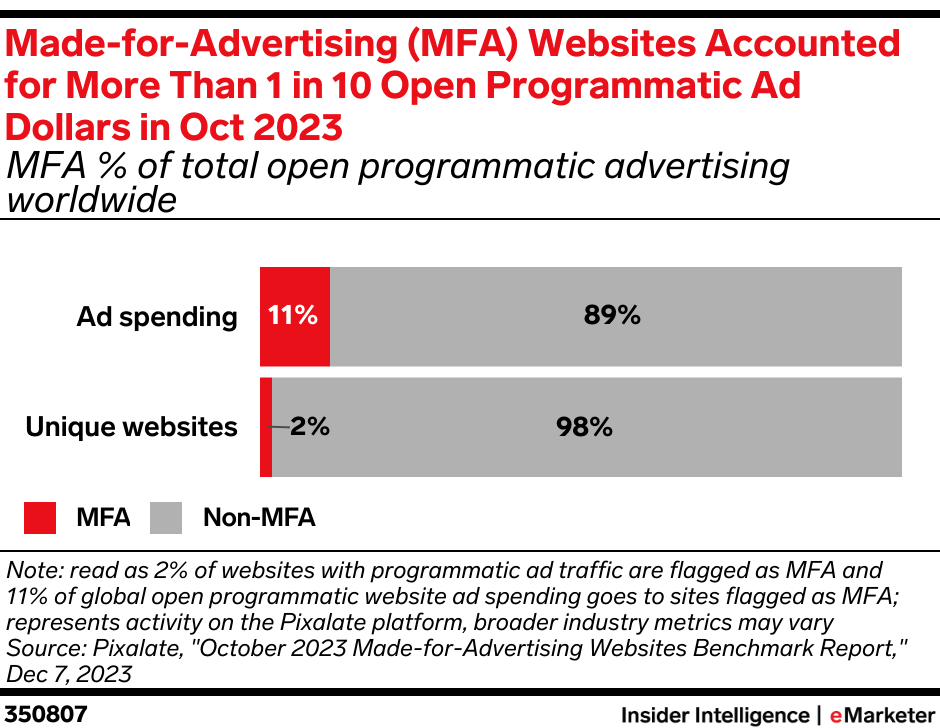The Rise and Risk of Made-for-Advertising (MFA) Sites
In 2024, Made-for-Advertising (MFA) websites have become a hot-button issue in the digital advertising industry, sparking debates over their impact on advertisers, publishers, and the broader ecosystem.
These sites, which prioritize ad revenue above all else, are now consuming a staggering proportion of ad spend, often with detrimental consequences for legitimate quality publishers.
What Are MFA Sites?
MFA sites are digital platforms created primarily to earn ad revenue, often through manipulative practices. Unlike legitimate publishers who invest in creating meaningful content and fostering loyal audiences, MFA sites prioritize ad impressions and clicks, frequently employing low-cost traffic and AI-generated or plagiarized content to attract users. Their typically very ad-heavy pages are designed to maximize impressions per session, resulting in poor user experiences and unsatisfied audiences.
Many MFA sites also display ads that aren’t visible to the human eye. This can be due to ad stacking and pixel stuffing, or other similar techniques that constitute ad fraud.

Source: Fraud Blocker
How Big is the MFA Problem?
Made-for-advertising (MFA) websites represent only 2% of unique websites globally. However, they command a significant 11% of total open programmatic ad spend, according to data from Pixalate in October 2023.

Source: eMarketer
Recent industry focused on addressing the MFA problem have helped curb spending on these platforms. As reported by ANA report, the share of media dollars spent on MFA sites has declined from 15% in late 2022 and early 2023 to just 4% between January and May 2024.
Initiatives like Google’s enhanced transparency for ad buyers, Yahoo’s commitment to avoid placing ads on MFA sites, and the launch of a detection tool by IAS are all instrumental in this progress.
The Impact of MFA Sites on Publishers
MFA sites are not just an advertiser problem. They directly impact legitimate publishers in several critical ways:
- Revenue Drain: Advertisers funneled $20 billion globally into MFA sites in 2023, money that could have gone to publishers producing high-quality content. This diversion leaves premium publishers competing for a shrinking share of ad budgets, despite offering superior environments for brands.
- Devaluation of CPM Rates: MFA sites drive down CPM rates by flooding the ecosystem with cheap inventory. Publishers who invest heavily in content creation and audience development struggle to justify premium pricing in a market saturated with low-cost, low-quality alternatives.
- Trust Erosion: MFA sites contribute to negative perceptions of programmatic advertising as a whole. Advertisers frustrated by poor campaign performance on MFA platforms may reduce their programmatic budgets, affecting even reputable publishers.
- Competition for Attention: As MFA sites saturate ad exchanges, they reduce the visibility of legitimate publisher inventory. “A lot of the conversation around MFA sites has focused on advertisers and their concerns about waste,” said eMarketer’s analyst Max Willens. “But the bigger issue is where that money isn’t going. Even the highest-quality web publishers are having a hard time right now, and so every dollar that goes to an MFA site takes money away from publishers that inform, entertain and connect our society.”
Adalytics, an ad quality and transparency platform, conducted a research that revealed that numerous MFA sites share the same analytics tags and account IDs, such as Facebook Pixel IDs and Google AdSense IDs, which are accessible in the HTML code of their sites. By combining this information with data from their ads.txt files, Adalytics was able to create a network graph highlighting shared ownership among multiple websites.
They also have a curated list of commonly identified MFA sites so that advertisers can exclude them from their campaigns.
The Current State of MFA Problem
Adalytics’ January 2024 analysis found that hundreds of brands, including ANA members, continue to have ads placed on MFA websites, despite industry pledges to eliminate such placements. A Fortune 500 company alone spent over $10 million on MFA sites across programmatic and non-programmatic channels.
MFA sites accounted for 21% of impressions per an ANA report in 2023. While vendors like Sharethrough, Google, and PubMatic have introduced MFA-blocking measures, the study underscores the need for advertisers to verify these claims to ensure compliance and protect ad budgets.
Why Hasn’t the Industry Eliminated MFAs?
The elimination of MFA is not an easy task. One significant obstacle is the lack of a universally agreed-upon definition for MFA sites. However, a group of leading ad trade associations, including the ANA, 4As, WFA, and ISBA, has worked together to define common characteristics.
According to them, MFA sites typically have:
- High ad-to-content density
- Auto-refresh ad placements
- Heavy reliance on paid traffic or traffic arbitrage (often 80-100% of their traffic is non-organic)
- Low-quality, generic, or templated content, and are often poorly designed using templates
Companies are also creating industry-wide exclusion lists to minimize MFA sites’ presence. However, a significant challenge is the risk of misclassification, as legitimate media companies might be mistakenly labeled as MFA, which underscores the importance of thorough evaluation by ad tech platforms.
As mentioned before, some MFA sites may utilize ad fraud practices. However, this is not a prerequisite, which makes classification difficult.
Another barrier to eliminating MFAs is the financial incentive for both ad tech platforms and buyers. Many platforms are reluctant to act due to the revenue generated by MFA sites, while buyers are often drawn to cheap media that boosts vanity metrics, even if the underlying value is questionable.
Despite increased transparency in programmatic advertising, the industry has yet to fully utilize tools like sellers.json, which verifies programmatic sellers. By leveraging such tools, companies could focus on genuine business outcomes rather than chasing metrics of limited value.
The persistence of MFA sites is further perpetuated by a systemic loop. Even when supply-side platforms (SSPs) remove MFA sites from private marketplaces or curated inventories, these sites often remain accessible on exchanges. This cycle of accessibility and purchase sustains the existence of MFAs, leading to inefficiencies, wasted ad spend, and unnecessary energy consumption for serving ineffective ads.
MFA publishers often use “zombie domains” that change frequently, making it challenging for advertisers to avoid them. While some SSPs claim to use tools like Jounce Media’s MFA tracker, static implementations may fail to keep up with daily updates.
Agencies or DSPs tasked with maximizing reach at low CPMs often end up buying MFA inventory, considered “cheap reach.” However, MFA sites inflate costs through ad reloads while providing little value to brands, as these placements primarily serve to boost attribution claims by platforms.
Although real users see MFA ads, they rarely translate into meaningful outcomes for brands, which often remain unaware of their exposure.
How Publishers Can Protect Themselves
Legitimate publishers need to take proactive steps to differentiate themselves and demonstrate the value they bring to advertisers:
1. Highlight Quality Metrics
Publishers can stand out by emphasizing metrics that matter to advertisers. Instead of focusing solely on impressions, showcase engagement rates, time-on-site, and conversion metrics. Advertisers increasingly value environments that foster genuine engagement over superficial KPIs like click-through rates.
2. Educate Advertisers
Many advertisers are unaware of how much of their budgets are wasted on MFA sites. By educating clients and partners about the risks of MFA inventory, publishers can position themselves as trusted advisors in the ad buying process.
For example, you can share data showing how campaigns on your site drive higher ROI compared to low-quality MFA environments. For instance, a study indicates that premium publishers deliver greater media performance outcomes than MFA publishers.
Source: Media Sense
3. Adopt Transparency Standards
By implementing tools like ads.txt, sellers.json, and OpenRTB SupplyChain Object, publishers can ensure their inventory is easily verifiable. These tools increase trust in programmatic transactions and help advertisers identify legitimate supply.
4. Leverage Private Marketplaces
To bypass the clutter of MFA-dominated open exchanges, publishers can establish private marketplaces (PMPs) that offer curated, premium inventory. PMPs often attract higher CPMs and provide advertisers with assurance that they’re investing in high-quality inventory.
5. Diversify Revenue Streams
Relying solely on programmatic advertising can leave publishers vulnerable to shifts in the ecosystem. Exploring alternative revenue models like subscriptions, memberships, or even retail media can reduce dependency on programmatic ad dollars.
Publishers Can Turn the MFA Problem Into Opportunity
While MFA sites present challenges, they also offer an opportunity for legitimate publishers to showcase their value. Advertisers burned by wasted budgets on MFA platforms are increasingly looking for safer, more effective environments. Publishers who can position themselves as high-quality alternatives stand to benefit.
For example, publishers in niche verticals with loyal audiences—such as technology, finance, or lifestyle—can leverage their reputation to attract advertisers seeking highly targeted campaigns. Partnering directly with media agencies can lead to increased revenues and more dynamic eCPMs for the publisher, while also delivering better outcomes for the agencies. And this works on the open exchange just as well as it does on private marketplaces.
Offering custom solutions like branded content partnerships or immersive ad formats can further differentiate your inventory from the MFA crowd.
Collaborating with the Industry
Legitimate publishers also have a role to play in the broader industry response to MFA sites:
- Advocacy for Standards: Publishers can collaborate with industry bodies like the IAB and ANA to push for clearer definitions of MFA sites and stricter enforcement of quality standards.
- Transparency in Reporting: By consistently providing advertisers with detailed performance reports, publishers can help set benchmarks for what ethical, effective advertising looks like.
- Supporting Ethical SSPs and DSPs: Partner with SSPs that actively filter out MFA inventory, like Kargo, Ozone Project, and TrustX and DSPs like Basis and The Trade Desk (as per Adalytics report). SSPs like Index Exchange and PubMatic have also recently made strides in prioritizing quality.
Conclusion
As the digital advertising industry grapples with the proliferation of MFA sites, publishers have a unique opportunity to lead the way toward a healthier ecosystem. By prioritizing transparency, emphasizing quality, and educating advertisers, publishers can not only protect their own revenue but also contribute to restoring trust in programmatic advertising.
In an era where billions of dollars are at stake, the publishers who succeed will be those who go beyond delivering impressions—they’ll deliver value.


